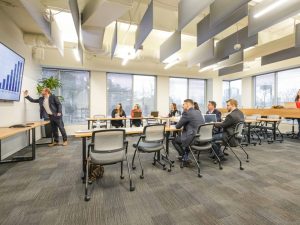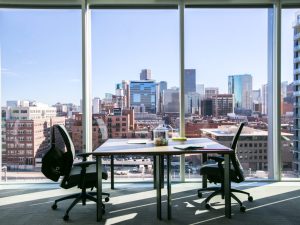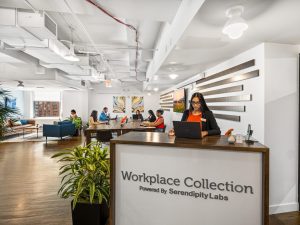The Future Has Never Been Brighter for Coworking, Says Serendipity Labs CEO
John Arenas on the sector’s strong growth prospects and the company’s expansion strategy.

Over the past 25 years, John Arenas founded three companies focused on meeting the evolving workplace landscape. Image courtesy of Serendipity Labs
As office demand continues to hurt due to many companies downsizing their footprints, an increasing number of landlords are embracing more collaborative and flexible spaces as the future of work. Catering to the growing need for adaptability in the workplace, the coworking sector remains at the forefront of this shift.
With almost 30 coworking spaces across the country and two locations in the U.K., Serendipity Labs provides landlords with flexible office solutions, creating hospitality-centric hubs that attract both tenants and their employees. Chairman & CEO John Arenas talked to Commercial Property Executive about the growing demand for flexibility—as opposed to long-term lease commitments—coworking market dynamics and the company’s growth strategy.
READ ALSO: Why Coworking Is Catching On
What are the main changes you noticed in the coworking industry in 2023?
Arenas: The potential market size for coworking has grown significantly with tenant demand for flexibility and service, but it may take another 12 to 24 months for companies to move forward with these more strategic real estate decisions.
Early in 2023, the coworking market and, more broadly, the flexible office space market felt strong demand from companies looking to shift from conventional long-term office leasing into coworking upon lease expiration. They wanted to gain flexibility, higher service levels and better access to transportation.
However, by mid-year, landlords were feeling the dual challenges of falling demand and rising costs of debt. They have become quite aggressive with renewal terms to keep tenants in place, even if with less space for a year. This has tempted companies that otherwise have thoughtful strategic plans toward outsourced workplaces to simply kick the can down the road once more by extending leases for short periods. We believe this only delays the inevitable move to an outsourced workplace for workspace requirements for under 100 employees per site.
What would you say are the top three trends in the flexible office space market today?

The Ideation Studio at Atlanta Perimeter Center is dedicated to larger team meetings. Image courtesy of Serendipity Labs
Arenas: New workplace dynamics have led to companies using coworking in new ways: higher desk-worker ratios, meeting and training use only, and programs that encourage drop-in work. Employees tend to be in the office less frequently and when they are it’s to collaborate, meet up, drop in, socialize and train.
A requirement for 50 people can be satisfied by a dedicated space with 25 or fewer desks. This same 50-person requirement would have been shopping for a 10,000-square-foot, 10-year lease in the past.
How has Serendipity Labs maintained and/or grown its presence in the coworking market?
Arenas: Serendipity Labs has been focused on being an inviting compliant outsourced workplace, which is a stronger value proposition than flexible desk rental. Our focus on suburban and secondary markets has put us in a good position to support distributed and remote work. The biggest advantage we have had is that the owners of each location are typically the landlords, for whom we manage and operate the coworking facility for a fee.
When a member signs with us, it is on our membership agreement. They get flexibility, service and access to a growing network of outsourced workplaces, but they are signing an agreement with the landlord. That’s a model many members like.
Since we manage the location for the landlord, member agreements are facilitated by us, but the counterparty is the landlord. We assume duty of care responsibilities for employees. Our IT platform is HIPAA, Sarbanes-Oxley, FINRA and e-commerce compliant. Another feature members prefer.
READ ALSO: As Hybrid Work Expands, Coworking Is No Longer the Exception
Each location is typically 25,000 to 40,000 square feet and serves a mix of companies that include high credit quality corporate accounts and regional businesses—companies that are subject-matter experts. By strategy and design, we have little exposure to any single industry or sector. Our locations are stable. If one industry hits a tough spot, the broad mix of members helps to balance it out.
There are coworking companies that attempted to ‘blitz-scale’ their businesses to satisfy venture capital investors. They signed traditional leases for locations concentrated in urban locations, at historically high rates. Often, they sublet to a single fast-moving company. When that company came to the end of its membership term, the coworking company was left with an entire empty location. That business model has had a day of reckoning.
In 2022, Serendipity Labs expanded its portfolio by 25 percent by adding new locations across the U.S. and the U.K. How was 2023 for your company? Have you grown your portfolio?

Denver LoDo Serendipity Labs offers a mix of private and team offices, as well as events space. Image courtesy of Serendipity Labs
Arenas: We’ve continued to grow by building new locations in the U.S. and U.K. This growth is also coming from landlord requirements to take over and convert coworking space that has come back to the landlords. While most of these are in urban centers, they are well located near major transportation and can serve as our ‘hub’ location in our hub-and-spoke network growth strategy.
Can you share a few details about the main locations you’ve added to your portfolio recently?
Arenas: Our strategy is to build a hub-and-spoke network of locations that can serve as a contiguous, trusted workplace where employees need to do work that day, meet as a team, and still be close to home.
We’ve recently added Cambridge. U.K., a suburb of London; Brentwood, Tenn., a suburb of Nashville; Nexton, S.C., a Charleston suburb; and Plano, Texas, a suburb of Dallas. They are all expansions to existing Serendipity Labs regional networks. Dublin, Calif., is our first in the Silicon Valley/San Francisco area.
Our 42nd Street location in Manhattan is steps from Grand Central, part of our most established, interconnected network. We have eight locations in the NY-Tri-State area, all near transportation hubs.
READ ALSO: Focus on Flexibility: Navigating NYC’s New Office Landscape
Tell us more about your tenant base. What strategies do you employ to attract tenants from different sectors?

Serendipity Labs Grand Central comprises 41,000 square feet of flex office space near NYC’s Grand Central Terminal. Image courtesy of Serendipity Labs
Arenas: We attract companies of all sizes, with about 50 percent coming from large- to mid-size companies, 30 percent from regional and professionals, and about 20 percent from small or fast-moving companies.
We have a powerful digital marketing platform that delivers more than 70 percent of our inquiries. In addition, we have a strong central corporate account and regional sales teams that call directly on customers and their advisors to enable their workplace strategies across our network of locations.
In a previous interview, you mentioned that Serendipity Labs offers flexible workspaces that foster connection, collaboration and focus. How do these concepts reverberate throughout the amenities spaces at your locations?
Arenas: Each location is designed with a 40-person Ideation Studio, Meetup Rooms and Board rooms that foster collaboration. Our locations also offer a work lounge and lab café to encourage drop-in work and casual meetings, and all serve to create a serendipity engine of sorts, as people engage and connect.
What are your thoughts on the future of coworking?
Arenas: I’ve been working in this flexible office industry leading companies for almost 30 years, through major economic shocks, global crises and disruption, but the future has never been brighter for coworking.
The workforce has fundamentally and permanently changed how they want to consume office space and workplace services. They want to be able to make good choices based on what work needs to be done and have been liberated from the myth and cult of the office in which presence was the primary measure of performance.







You must be logged in to post a comment.